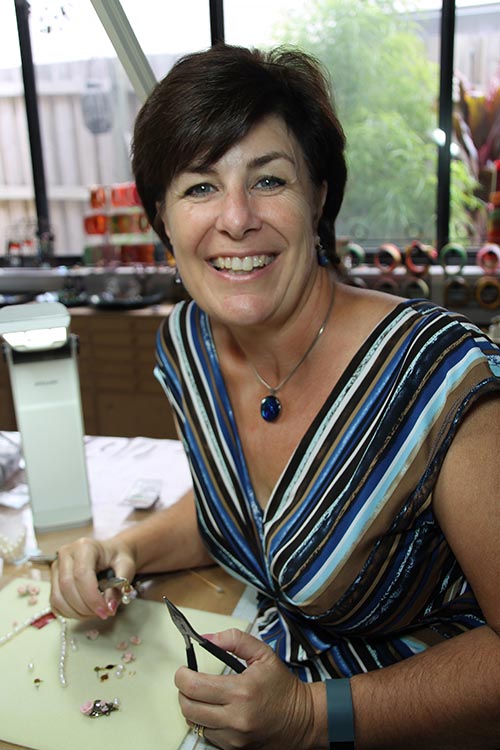Yesterday, I had a bad resin day! Sometimes, things don't go quite as planned: I had bad pours, spilled resin, bubbling issues, cross contamination, you name it, I seemed to be clumsy enough to do it. It was just one of those days! But that's not what this post is about. Those mess ups give me the opportunity to show you some of the things that can go wrong when working with quick curing polyurethane resin so that you can avoid them. Now, let's take a look at a couple of the things that didn't go according to plan. If you're working with epoxy resin, you might find this video useful: " Dealing with Bubbles in Resin ". Contaminants in Resin The first bangle has a little bit of bubbling in the resin (not unusual for polyurethane resin) but the biggest problem is what I'd describe as warts on the surface. The culprit here is contaminated resin dye . A crack in the lid of the colourant I used has allowed moisture to contaminate the dye...
Thursday, September 27, 2012
The Number 1 Thing Resin Hates!
Thursday, September 20, 2012
Revamping a Candelabra
About 10 years ago I bought an inexpensive candelabra which, after many years of neglect, had collected a thick layer of dust and wax. I always avoided cleaning it because it seemed like scraping off the melted wax would be a difficult thing to do. But for a special occasion in our household recently I decided it was time to tackle the job of cleaning it up. Who knew it would only take 10 minutes to clean?!! Check out how easy it is to do in the video and then see how it was transformed into a chic and elegant table decoration draped with beads and crystals - it's the perfect centrepiece for a wedding table or special dinner party. CheC 'Til next time..... If you can't get enough of My Tutorials and you want even more inspiration, click here to find my books and printable pdfs ...
Monday, September 17, 2012
Barnyard Girls Earrings
Here's a pair of whimsical, barnyard inspired earrings that are fun and easy to make using a simple wire technique to create the feet. What you'll need: Materials 2 x lampwork chicken beads 20 gauge non tarnish silver wire 2 x 4mm silver bicone beads 2 x 6mm silver bead caps 2 x 6mm silver spacer beads - mine look like a bon bon (with a flare at the top and bottom), but a plain cylinder spacer bead will also work Pair silver earring wires Tools Chain nose pliers Flat nose pliers Round nose pliers Flush cutters Cut a length of wire 12.5cm (5") long and bend it at a 90° angle, about 2.5cm (1") from the end. Hold the flat nose pliers in the corner of the angle just created (on the long end) and bend the wire back around the outside of the jaw. This will create the first claw. Repeat the last step to create 3 claws altogether. Shape the claws by gently squeezing each one together at the base with the pliers. You want to make sure that t...
Thursday, September 13, 2012
Beads with a Twist
If you've ever managed to catch me demoing at the craft shows in Brisbane or Sydney you are sure to have seen me work with Friendly Plastic. One of the most popular things I demo is the Twist Bead. It always draws a big crowd and lots of Ah-ha 's as onlookers see the wonderful spirals appear around the bead. But if you haven't seen a twist bead made before then check out the video below to see just how clever it is. This one is for all my fellow Friendly Plastic addicts :) 'Til next time........ ...
Wednesday, September 12, 2012
Man Cave Resin Coaster Kit
Now that my silicone coaster mould is cured I'm all set to cast the first Man Cave resin coaster - the gifts my son is giving to his mates for Christmas. Beer bottle caps would have to be THE perfect item to embed in coasters for guys in their early 20s (or maybe any age!). My son has been collecting bottle caps for this project for months and I've been busting to get started on it. So whilst the silicone mould was curing, I began by preparing the bottle caps. I started by filling them with resin. I'm so glad I did this before setting the caps into the resin because a few bubbles got caught around the rubber lining of each cap and it was easier to pop them before they were set into the coaster mould rather than after. It also made them heavy enough so they didn't float to the surface when I filled the mould. As soon as the silicone was cured I was able to start pouring resin into the mould - just a shallow layer to begin with. Once this was at the soft cu...
Monday, September 10, 2012
Silicone Mould in a Box
My son has put in a special order for some personalised gifts to give to his friends for Christmas. They are all in their early 20s and enjoy having a quiet drink together so we decided that resin drink coasters would make a great gift. No problems, I thought. But before that can happen, I need a mould so today I finally had reason to do something I've wanted to do for a long time: create a silicone coaster mould. To make the mould making process easier, I invested in a mould box and I've got to say that this is simply the best investment I've made in quite a while. All you have to do is clamp the four walls together, putty the gaps so the silicone can't leak out and your mould box is ready to use. After securing my master to the bottom of the mould, I mixed and poured the silicone around it and then waited for it to cure..... too easy! The plan is to make several of these moulds so that I can cast a whole set of coasters at a time but unfortunately, t...
Wednesday, September 5, 2012
Jewellery Repair - How to Re-attach Bead Tips or Calottes
It's jewellery repair day and I wanted to share a piece I've been working on today, not because it's a great repair job but because it's such a cool necklace! It features a selection of really BIG wooden safari animal beads making it a fun necklace that really grabs your attention. Originally, it was strung on fishing line but it had unravelled in parts and a few of the round wooden beads were lost but other than that, it's in great condition. One strand of this double-stranded necklace has broken and some of the beads have been lost. There was little hope of matching those missing beads so it was just a matter of replacing them with a few beads from the back of the necklace where they won't be missed at all. It's a very straight forward stringing repair. I've been able to re-use all the findings but I replaced the fishing line with two strands of Fireline to make it really durable and strong. The two strands are actually part of the design too....
Monday, September 3, 2012
Hot Neon Resin Jewellery
Neon is all the rage at the moment. It visited us in the 70s, the 80s and the 90s and yet it's still so fresh... what a contradiction! The thing about neon is that it doesn't blend with other colours. It is what it is - eye popping colour that stands out a mile. The trick to wearing it successfully is to wear just a touch of it so that you don't glow like a neon glow stick. Add just a couple of neon accessories like a bangle and belt to a plain outfit and you'll hit a good balance and still be in fashion. I've had a bit of fun making neon resin bangles and rings over the last few days using some retro bangle and ring shapes - they suit the neon colours perfectly! But if you feel a little intimidated by the full on glow of these electric colours and still want to be in fashion, you can compromise and choose pastel neon like the ones I cast in my first session. They are still neon coloured, but just not as intense. Don't you love the square? It's thi...
Subscribe to:
Posts (Atom)











